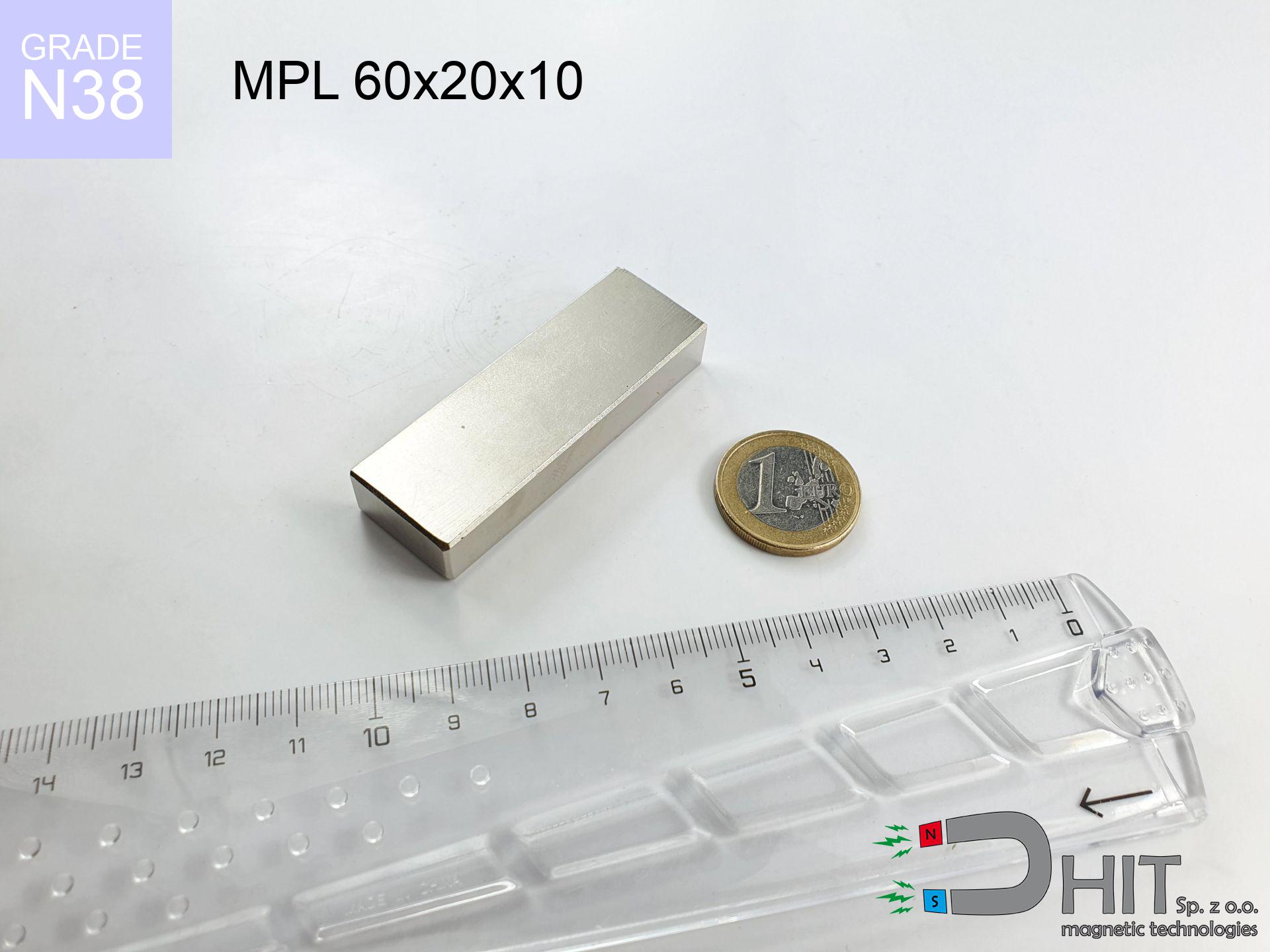SM 25x150 [2xM8] / N52 - magnetic separator
magnetic separator
Catalog no 130368
GTIN/EAN: 5906301813163
Diameter Ø
25 mm [±1 mm]
Height
150 mm [±1 mm]
Weight
560 g
Magnetic Flux
~ 9 500 Gauss [±5%]
467.40 ZŁ with VAT / pcs + price for transport
380.00 ZŁ net + 23% VAT / pcs
bulk discounts:
Need more?
Call us now
+48 22 499 98 98
or get in touch via
request form
the contact form page.
Strength and appearance of neodymium magnets can be reviewed on our
force calculator.
Orders placed before 14:00 will be shipped the same business day.
Product card - SM 25x150 [2xM8] / N52 - magnetic separator
Specification / characteristics - SM 25x150 [2xM8] / N52 - magnetic separator
| properties | values |
|---|---|
| Cat. no. | 130368 |
| GTIN/EAN | 5906301813163 |
| Production/Distribution | Dhit sp. z o.o. |
| Country of origin | Poland / China / Germany |
| Customs code | 85059029 |
| Diameter Ø | 25 mm [±1 mm] |
| Height | 150 mm [±1 mm] |
| Weight | 560 g |
| Material Type | Stainless steel AISI 304 / A2 |
| Magnetic Flux | ~ 9 500 Gauss [±5%] |
| Size/Mount Quantity | 2xM8 |
| Polarity | circumferential - 5 poles |
| Casing Tube Thickness | 1 mm |
| Manufacturing Tolerance | ±1 mm |
Magnetic properties of material N52
| properties | values | units |
|---|---|---|
| remenance Br [min. - max.] ? | 14.2-14.7 | kGs |
| remenance Br [min. - max.] ? | 1420-1470 | mT |
| coercivity bHc ? | 10.8-12.5 | kOe |
| coercivity bHc ? | 860-995 | kA/m |
| actual internal force iHc | ≥ 12 | kOe |
| actual internal force iHc | ≥ 955 | kA/m |
| energy density [min. - max.] ? | 48-53 | BH max MGOe |
| energy density [min. - max.] ? | 380-422 | BH max KJ/m |
| max. temperature ? | ≤ 80 | °C |
Physical properties of sintered neodymium magnets Nd2Fe14B at 20°C
| properties | values | units |
|---|---|---|
| Vickers hardness | ≥550 | Hv |
| Density | ≥7.4 | g/cm3 |
| Curie Temperature TC | 312 - 380 | °C |
| Curie Temperature TF | 593 - 716 | °F |
| Specific resistance | 150 | μΩ⋅cm |
| Bending strength | 250 | MPa |
| Compressive strength | 1000~1100 | MPa |
| Thermal expansion parallel (∥) to orientation (M) | (3-4) x 10-6 | °C-1 |
| Thermal expansion perpendicular (⊥) to orientation (M) | -(1-3) x 10-6 | °C-1 |
| Young's modulus | 1.7 x 104 | kg/mm² |
Table 1: Rod construction
SM 25x150 [2xM8] / N52
| Parameter | Value | Description / Unit |
|---|---|---|
| Diameter (Ø) | 25 | mm |
| Total length | 150 | mm (L) |
| Active length | 114 | mm |
| Section count | 4 | modules |
| Dead zone | 36 | mm (2x 18mm starter) |
| Weight (est.) | ~560 | g |
| Active area | 90 | cm² (Area) |
| Housing material | AISI 304 | 1.4301 (Inox) |
| Surface finish | Ra < 0.8 µm | Polished |
| Temp. class | 80°C | Standard (N) |
| Force loss (at max °C) | -12.8% | Reversible loss (physics) |
| Force (calculated) | 22.6 | kg (theor.) |
| Induction (surface) | ~9 500 | Gauss (Max) |
Chart 2: Field profile (4 sections)
Chart 3: Temperature performance
Chemical composition
| iron (Fe) | 64% – 68% |
| neodymium (Nd) | 29% – 32% |
| boron (B) | 1.1% – 1.2% |
| dysprosium (Dy) | 0.5% – 2.0% |
| coating (Ni-Cu-Ni) | < 0.05% |
Sustainability
| recyclability (EoL) | 100% |
| recycled raw materials | ~10% (pre-cons) |
| carbon footprint | low / zredukowany |
| waste code (EWC) | 16 02 16 |
Other deals
Strengths as well as weaknesses of rare earth magnets.
Benefits
- Their power remains stable, and after around ten years it decreases only by ~1% (according to research),
- They have excellent resistance to weakening of magnetic properties due to opposing magnetic fields,
- The use of an elegant finish of noble metals (nickel, gold, silver) causes the element to look better,
- They show high magnetic induction at the operating surface, making them more effective,
- Made from properly selected components, these magnets show impressive resistance to high heat, enabling them to function (depending on their form) at temperatures up to 230°C and above...
- Considering the possibility of accurate forming and customization to specialized requirements, magnetic components can be created in a variety of geometric configurations, which amplifies use scope,
- Universal use in innovative solutions – they are used in computer drives, motor assemblies, medical equipment, also industrial machines.
- Relatively small size with high pulling force – neodymium magnets offer strong magnetic field in compact dimensions, which enables their usage in compact constructions
Cons
- At very strong impacts they can break, therefore we advise placing them in steel cases. A metal housing provides additional protection against damage, as well as increases the magnet's durability.
- When exposed to high temperature, neodymium magnets suffer a drop in strength. Often, when the temperature exceeds 80°C, their power decreases (depending on the size, as well as shape of the magnet). For those who need magnets for extreme conditions, we offer [AH] versions withstanding up to 230°C
- When exposed to humidity, magnets usually rust. To use them in conditions outside, it is recommended to use protective magnets, such as those in rubber or plastics, which prevent oxidation as well as corrosion.
- Due to limitations in realizing threads and complicated forms in magnets, we propose using casing - magnetic mechanism.
- Possible danger related to microscopic parts of magnets are risky, if swallowed, which becomes key in the context of child health protection. Furthermore, small elements of these devices can be problematic in diagnostics medical after entering the body.
- With large orders the cost of neodymium magnets is a challenge,
Holding force characteristics
Detachment force of the magnet in optimal conditions – what affects it?
- on a base made of mild steel, perfectly concentrating the magnetic field
- possessing a thickness of minimum 10 mm to ensure full flux closure
- characterized by even structure
- with direct contact (without impurities)
- under perpendicular force vector (90-degree angle)
- in temp. approx. 20°C
Lifting capacity in practice – influencing factors
- Gap (between the magnet and the metal), since even a tiny clearance (e.g. 0.5 mm) leads to a decrease in force by up to 50% (this also applies to paint, corrosion or debris).
- Loading method – catalog parameter refers to detachment vertically. When attempting to slide, the magnet holds much less (typically approx. 20-30% of nominal force).
- Wall thickness – thin material does not allow full use of the magnet. Part of the magnetic field passes through the material instead of generating force.
- Steel grade – ideal substrate is pure iron steel. Hardened steels may attract less.
- Plate texture – ground elements guarantee perfect abutment, which increases field saturation. Rough surfaces reduce efficiency.
- Heat – neodymium magnets have a sensitivity to temperature. At higher temperatures they lose power, and at low temperatures they can be stronger (up to a certain limit).
Lifting capacity was determined with the use of a steel plate with a smooth surface of suitable thickness (min. 20 mm), under vertically applied force, however under attempts to slide the magnet the lifting capacity is smaller. Additionally, even a small distance between the magnet’s surface and the plate reduces the holding force.
Safety rules for work with neodymium magnets
Fragile material
Despite the nickel coating, the material is delicate and cannot withstand shocks. Do not hit, as the magnet may crumble into hazardous fragments.
Phone sensors
Remember: rare earth magnets generate a field that disrupts sensitive sensors. Keep a safe distance from your mobile, device, and navigation systems.
Choking Hazard
These products are not intended for children. Swallowing several magnets can lead to them attracting across intestines, which poses a critical condition and necessitates immediate surgery.
Electronic hazard
Do not bring magnets near a purse, laptop, or screen. The magnetism can irreversibly ruin these devices and erase data from cards.
Medical implants
For implant holders: Strong magnetic fields affect electronics. Keep at least 30 cm distance or request help to work with the magnets.
Do not underestimate power
Before use, read the rules. Sudden snapping can break the magnet or hurt your hand. Think ahead.
Do not overheat magnets
Keep cool. Neodymium magnets are susceptible to heat. If you need operation above 80°C, ask us about HT versions (H, SH, UH).
Skin irritation risks
It is widely known that nickel (the usual finish) is a common allergen. If your skin reacts to metals, avoid touching magnets with bare hands and choose coated magnets.
Bone fractures
Pinching hazard: The attraction force is so immense that it can cause blood blisters, pinching, and even bone fractures. Protective gloves are recommended.
Fire risk
Mechanical processing of neodymium magnets poses a fire risk. Neodymium dust reacts violently with oxygen and is hard to extinguish.

![Separation magnetic rod SM 25x150 [2xM8] / N52 Separation magnetic rod SM 25x150 [2xM8] / N52](https://cdn3.dhit.pl/graphics/banners/magnet.webp)
![SM 25x150 [2xM8] / N52 - magnetic separator](https://cdn3.dhit.pl/graphics/products/sm-25x150-2xm8-sux.jpg)


![UMH 75x18x68 [M8] / N38 - magnetic holder with hook UMH 75x18x68 [M8] / N38 - magnetic holder with hook](https://cdn3.dhit.pl/graphics/products/umh-75x18x68-m8-wag.jpg)


